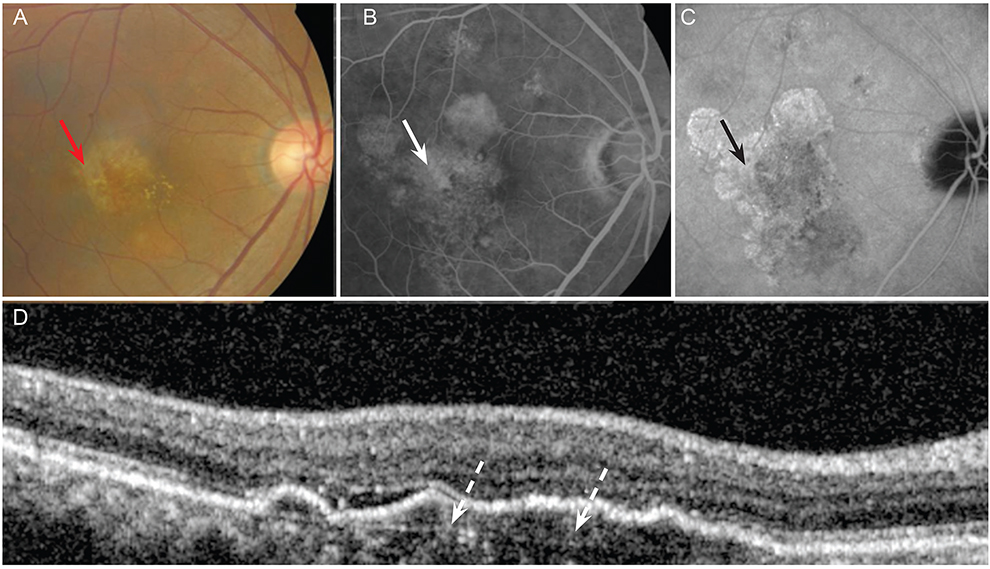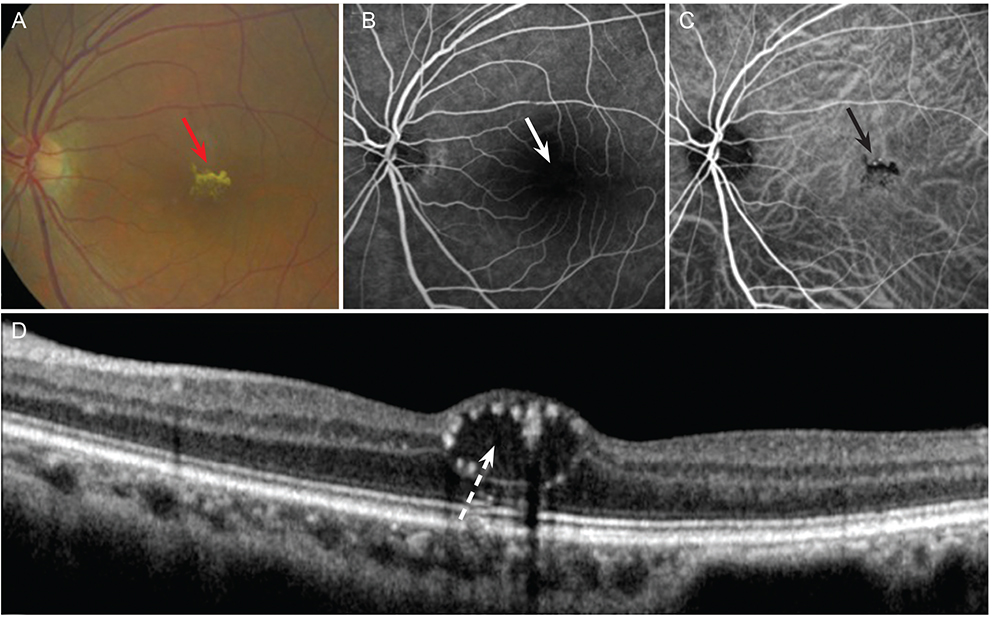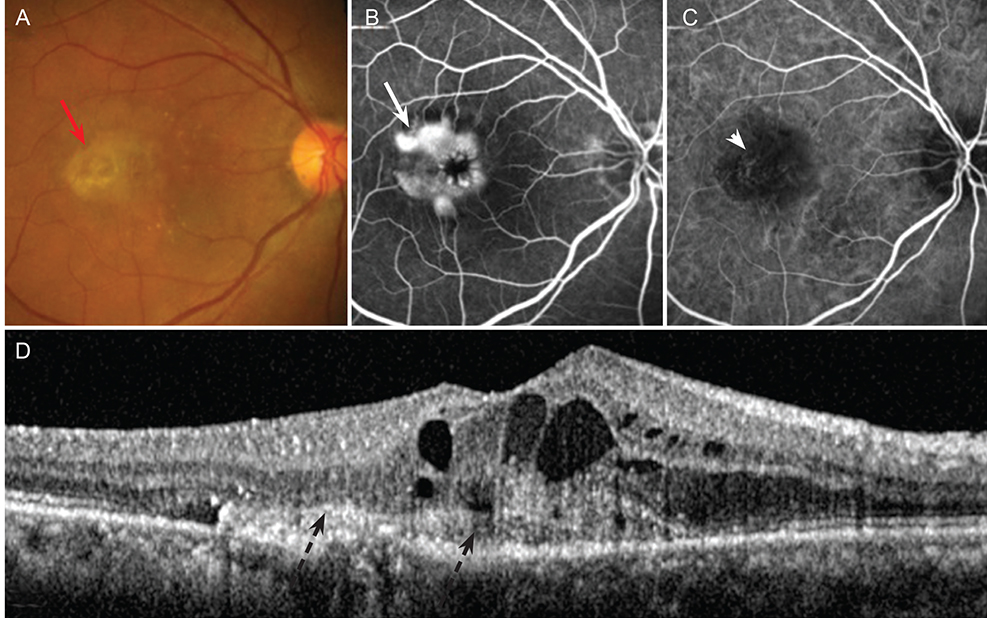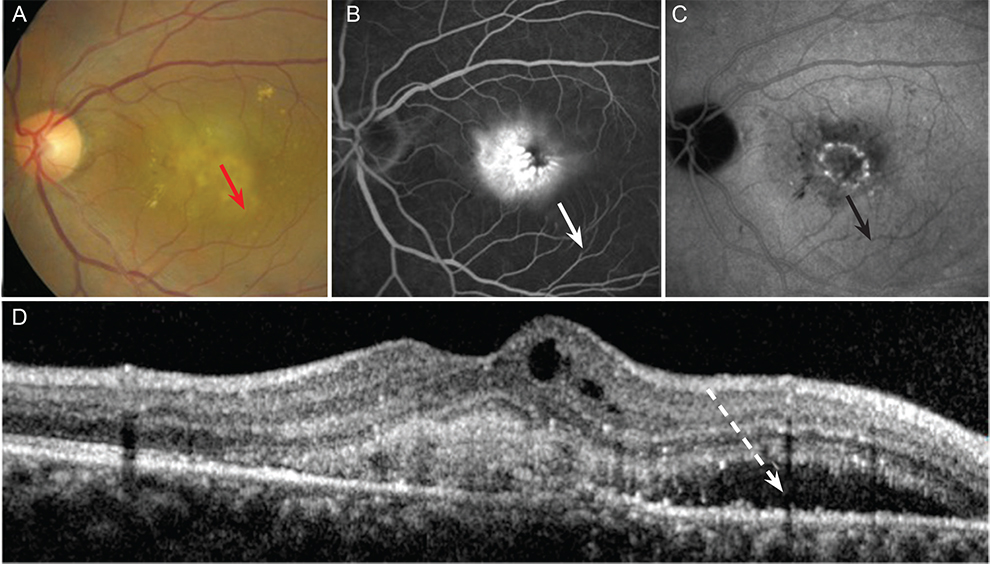Korean J Ophthalmol.
2013 Oct;27(5):351-360. 10.3341/kjo.2013.27.5.351.
Characteristic Findings of Optical Coherence Tomography in Retinal Angiomatous Proliferation
- Affiliations
-
- 1Myung-Gok Eye Research Institute, Konyang University Kim's Eye Hospital, Seoul, Korea. han66139@kimeye.com
- KMID: 1707289
- DOI: http://doi.org/10.3341/kjo.2013.27.5.351
Abstract
- PURPOSE
To identify the unique pathologic findings of retinal angiomatous proliferation (RAP) in optical coherence tomography (OCT).
METHODS
Retrospectively, 29 eyes of 25 patients with age-related macular degeneration and complicated RAP were analyzed. All 29 eyes had choroidal neovascularization (CNV) in the area of pigment epithelial detachment (PED) or adjacent to it, which was visible with fluorescein angiography or indocyanine green angiography. Cross-sectional images were obtained by OCT scanning through the CNV lesions.
RESULTS
Six distinctive findings of OCT included drusen (100%), inner retinal cyst (80%), outer retinal cyst (68%), fibrovascular PED (84%), serous retinal detachment (40%), and PED (68%).
CONCLUSIONS
Through analysis of OCT findings, we revealed six different types of lesions distinctive of RAP which may provide helpful diagnostic information for subsequent treatment and predicting the prognosis of RAP.
Keyword
MeSH Terms
Figure
Reference
-
1. Dell'Omo R, Cassetta M, dell'Omo E, et al. Aqueous humor levels of vascular endothelial growth factor before and after intravitreal bevacizumab in type 3 versus type 1 and 2 neovascularization: a prospective, case-control study. Am J Ophthalmol. 2012; 153:155–161.e2.2. Brancato R, Introini U, Pierro L, et al. Optical coherence tomography (OCT) angiomatous prolifieration (RAP) in retinal. Eur J Ophthalmol. 2002; 12:467–472.3. Rouvas AA, Papakostas TD, Ntouraki A, et al. Angiographic and OCT features of retinal angiomatous proliferation. Eye (Lond). 2010; 24:1633–1642.4. Yannuzzi LA, Negrao S, Iida T, et al. Retinal angiomatous proliferation in age-related macular degeneration. Retina. 2001; 21:416–434.5. Hartnett ME, Weiter JJ, Garsd A, Jalkh AE. Classification of retinal pigment epithelial detachments associated with drusen. Graefes Arch Clin Exp Ophthalmol. 1992; 230:11–19.6. Kuhn D, Meunier I, Soubrane G, Coscas G. Imaging of chorioretinal anastomoses in vascularized retinal pigment epithelium detachments. Arch Ophthalmol. 1995; 113:1392–1398.7. Hartnett ME, Weiter JJ, Staurenghi G, Elsner AE. Deep retinal vascular anomalous complexes in advanced age-related macular degeneration. Ophthalmology. 1996; 103:2042–2053.8. Slakter JS, Yannuzzi LA, Schneider U, et al. Retinal choroidal anastomoses and occult choroidal neovascularization in age-related macular degeneration. Ophthalmology. 2000; 107:742–753.9. Lafaut BA, Aisenbrey S, Vanden Broecke C, Bartz-Schmidt KU. Clinicopathological correlation of deep retinal vascular anomalous complex in age related macular degeneration. Br J Ophthalmol. 2000; 84:1269–1274.10. Yannuzzi LA, Slakter JS, Sorenson JA, et al. Digital indocyanine green videoangiography and choroidal neovascularization. Retina. 1992; 12:191–223.11. Yannuzzi LA, Hope-Ross M, Slakter JS, et al. Analysis of vascularized pigment epithelial detachments using indocyanine green videoangiography. Retina. 1994; 14:99–113.12. Wolf S, Wolf-Schnurrbusch U. Spectral-domain optical coherence tomography use in macular diseases: a review. Ophthalmologica. 2010; 224:333–340.13. Susan BB, Neil M, Bressler . Age-related macular degeneration: non-neovascular early AMD, intermediate AMD, and geographic atrophy. In : Schachat AP, Ryan SJ, editors. Retina. 5th ed. London: Elsevier;2013. p. 1161.14. Gass JD. Serous retinal pigment epithelial detachment with a notch: a sign of occult choroidal neovascularization. Retina. 1984; 4:205–220.15. Wolff B, Maftouhi MQ, Mateo-Montoya A, et al. Outer retinal cysts in age-related macular degeneration. Acta Ophthalmol. 2011; 89:e496–e499.16. Fernandes LH, Freund KB, Yannuzzi LA, et al. The nature of focal areas of hyperfluorescence or hot spots imaged with indocyanine green angiography. Retina. 2002; 22:557–568.17. Zacks DN, Johnson MW. Retinal angiomatous proliferation: optical coherence tomographic confirmation of an intraretinal lesion. Arch Ophthalmol. 2004; 122:932–933.18. Chan WM, Lai TY, Lai RY, et al. Half-dose verteporfin photodynamic therapy for acute central serous chorioretinopathy: one-year results of a randomized controlled trial. Ophthalmology. 2008; 115:1756–1765.19. Khanifar AA, Koreishi AF, Izatt JA, Toth CA. Drusen ultrastructure imaging with spectral domain optical coherence tomography in age-related macular degeneration. Ophthalmology. 2008; 115:1883–1890.20. Cohen SY, Dubois L, Tadayoni R, et al. Prevalence of reticular pseudodrusen in age-related macular degeneration with newly diagnosed choroidal neovascularisation. Br J Ophthalmol. 2007; 91:354–359.21. Leveziel N, Puche N, Richard F, et al. Genotypic influences on severity of exudative age-related macular degeneration. Invest Ophthalmol Vis Sci. 2010; 51:2620–2625.22. Liakopoulos S, Ongchin S, Bansal A, et al. Quantitative optical coherence tomography findings in various subtypes of neovascular age-related macular degeneration. Invest Ophthalmol Vis Sci. 2008; 49:5048–5054.23. Zweifel SA, Engelbert M, Laud K, et al. Outer retinal tubulation: a novel optical coherence tomography finding. Arch Ophthalmol. 2009; 127:1596–1602.24. Doukas J, Mahesh S, Umeda N, et al. Topical administration of a multi-targeted kinase inhibitor suppresses choroidal neovascularization and retinal edema. J Cell Physiol. 2008; 216:29–37.25. Coscas F, Coscas G, Souied E, et al. Optical coherence tomography identification of occult choroidal neovascularization in age-related macular degeneration. Am J Ophthalmol. 2007; 144:592–599.26. Sato T, Iida T, Hagimura N, Kishi S. Correlation of optical coherence tomography with angiography in retinal pigment epithelial detachment associated with age-related macular degeneration. Retina. 2004; 24:910–914.
- Full Text Links
- Actions
-
Cited
- CITED
-
- Close
- Share
- Similar articles
-
- Comparison of Optical Coherence Tomography Characteristics among Three Subtypes of Exudative Age-related Macular Degeneration
- Optical Coherence Tomography Findings in Best Disease
- Fundus Autofluorescence, Fluorescein Angiography and Spectral Domain Optical Coherence Tomography Findings of Retinal Astrocytic Hamartomas in Tuberous Sclerosis
- Foveal Retinal Detachment Diagnosed by Optical Coherence Tomography after Successful Retinal Detachment Surgery
- Assessment of retinal degeneration with optical coherence tomography in a dog







